I do a lot of Vietnamese cooking at home, and the unique flavor of lemongrass is one of my absolute favorites.
I love it in these Vietnamese pulled pork tacos which are so simple to make, but taste fancy enough to serve at a dinner party (the pulled pork is great with rice too).
I also love making lemongrass simple syrup to use in my sparkling summer sangria and fresh lemongrass-ginger ale, which are just the thing to revive you on a hot summer afternoon after being in the garden all day.
When I first discovered you can propagate lemongrass from store-bought stalks, I drove right down to the local market and picked up a bundle of fresh lemongrass stalks to root in water.
Propagating plants from living herbs is a fun way to score new plants for your garden. It’s like you’re getting free plants, even if you bought them.
Think of it this way: You spent a few dollars for a handful of lemongrass stalks, but you’ll turn them into hundreds of new stalks over the course of many years. And I’ll show you exactly how to do it!
Growing lemongrass in a cold climate—it’s possible!
I rooted store-bought lemongrass for my previous garden in Southern California, and the plants grew healthy and strong for seven years (right until we moved away) and are still thriving under the new owners’ care.
(This is what the lemongrass looked like after two years in the ground. Each clump began as three rooted stalks.)
Rather than digging them up and taking the plants with us, I decided to start a brand-new lemongrass clump in our current home in Central Oregon. It won’t survive frost in this climate, but it’ll flourish outside in summer and live indoors in winter.
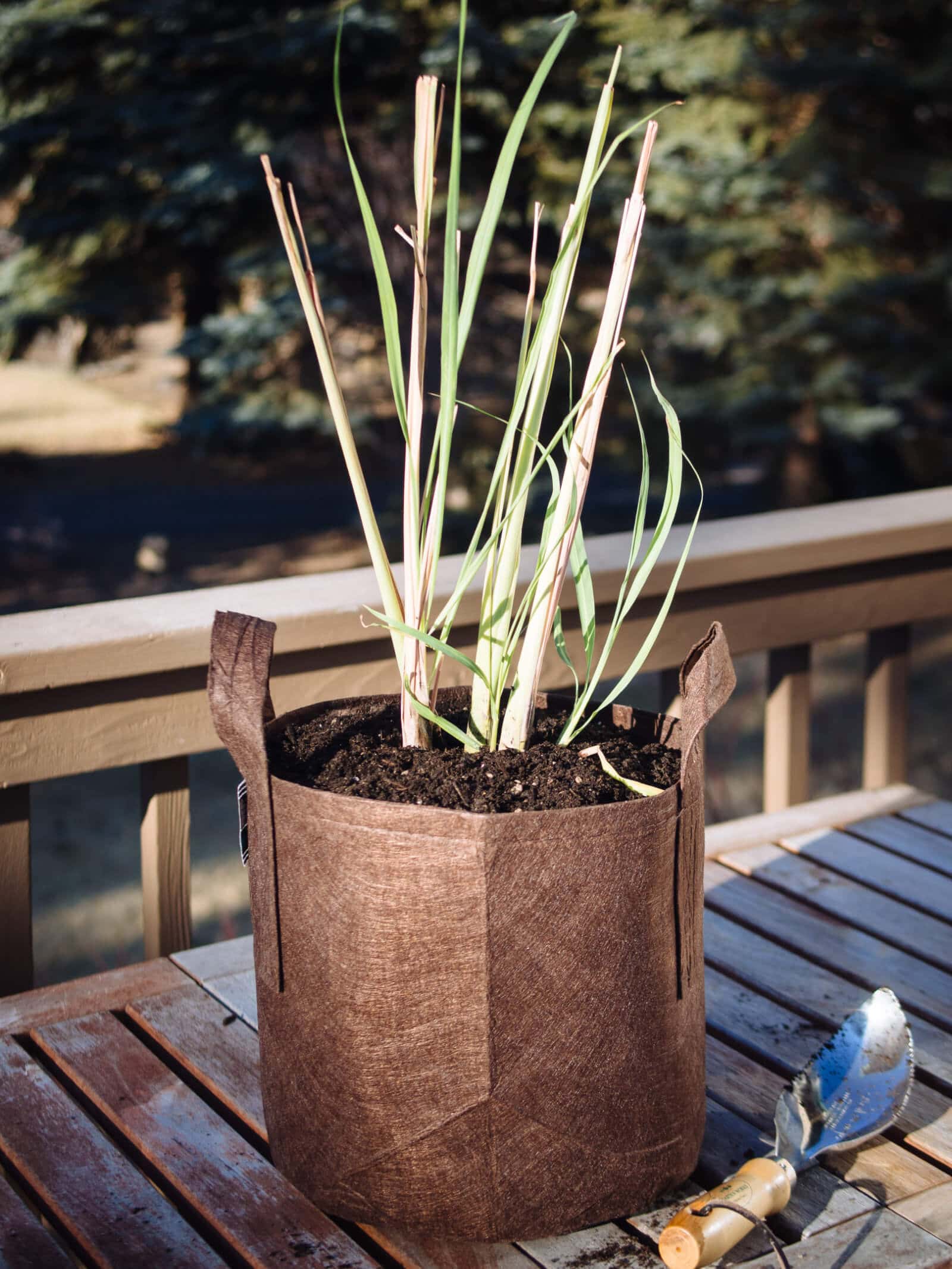
That means the new lemongrass is a container plant that moves happily between our house, greenhouse, and yard, and we’ve since repotted it into a larger container (than what you see in these pictures) so we can have a bigger harvest.
I’ve updated this post (originally published in 2010—one of the very first posts on my blog, if you can believe it!) to show my fool-proof method for starting your own lemongrass plant from store-bought stalks. (Even if you live somewhere cold.)
I’ll also share what I’ve learned after rooting the herb in a warm climate versus cool climate, because there was a big difference in rooting time!
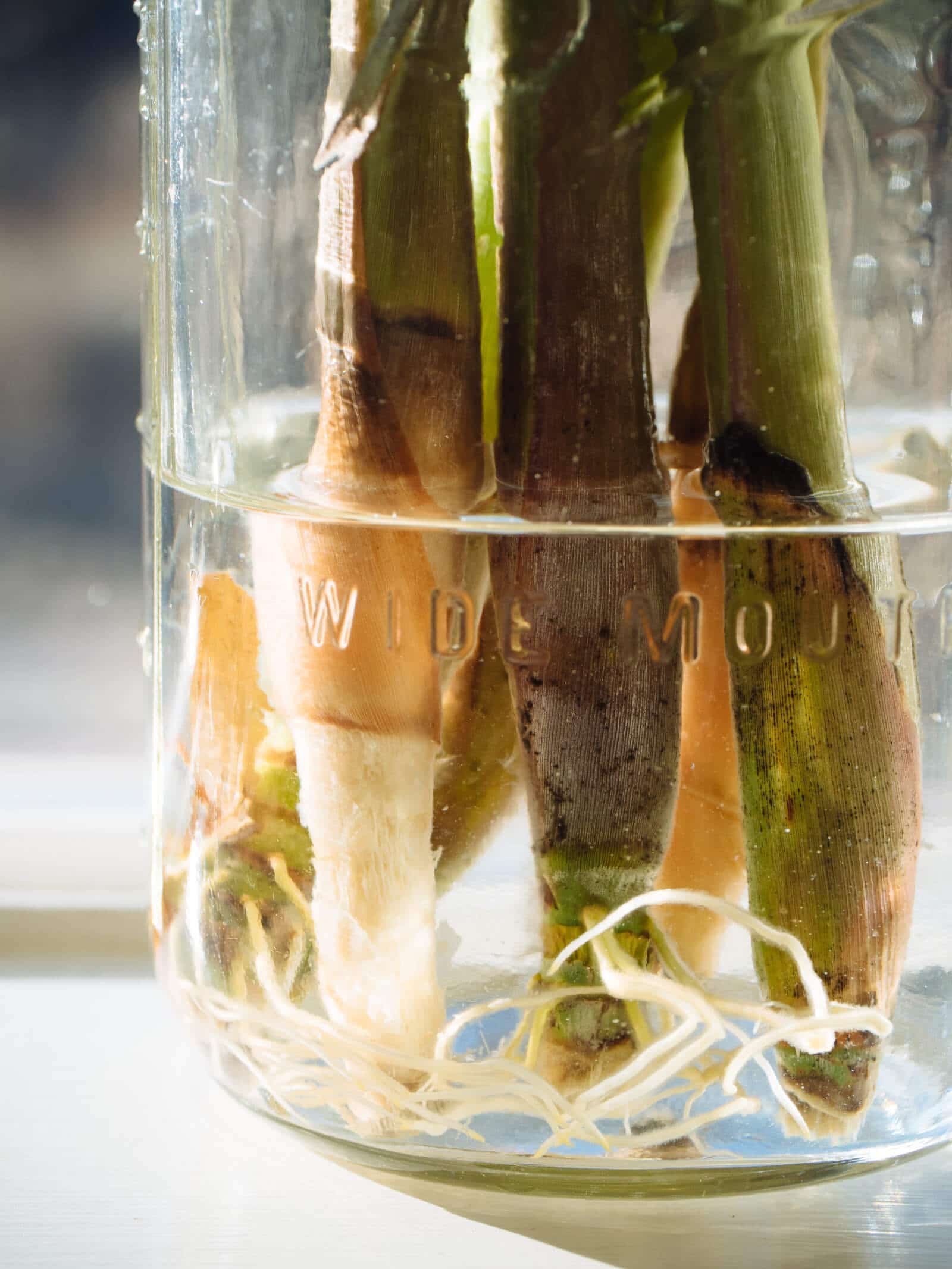
How to propagate lemongrass from store-bought stalks
1. Start with fresh lemongrass with the entire stem intact.
The stalks you buy don’t need (and probably won’t have) roots at the bottom, but they do need to have the the entire stem (base) intact.

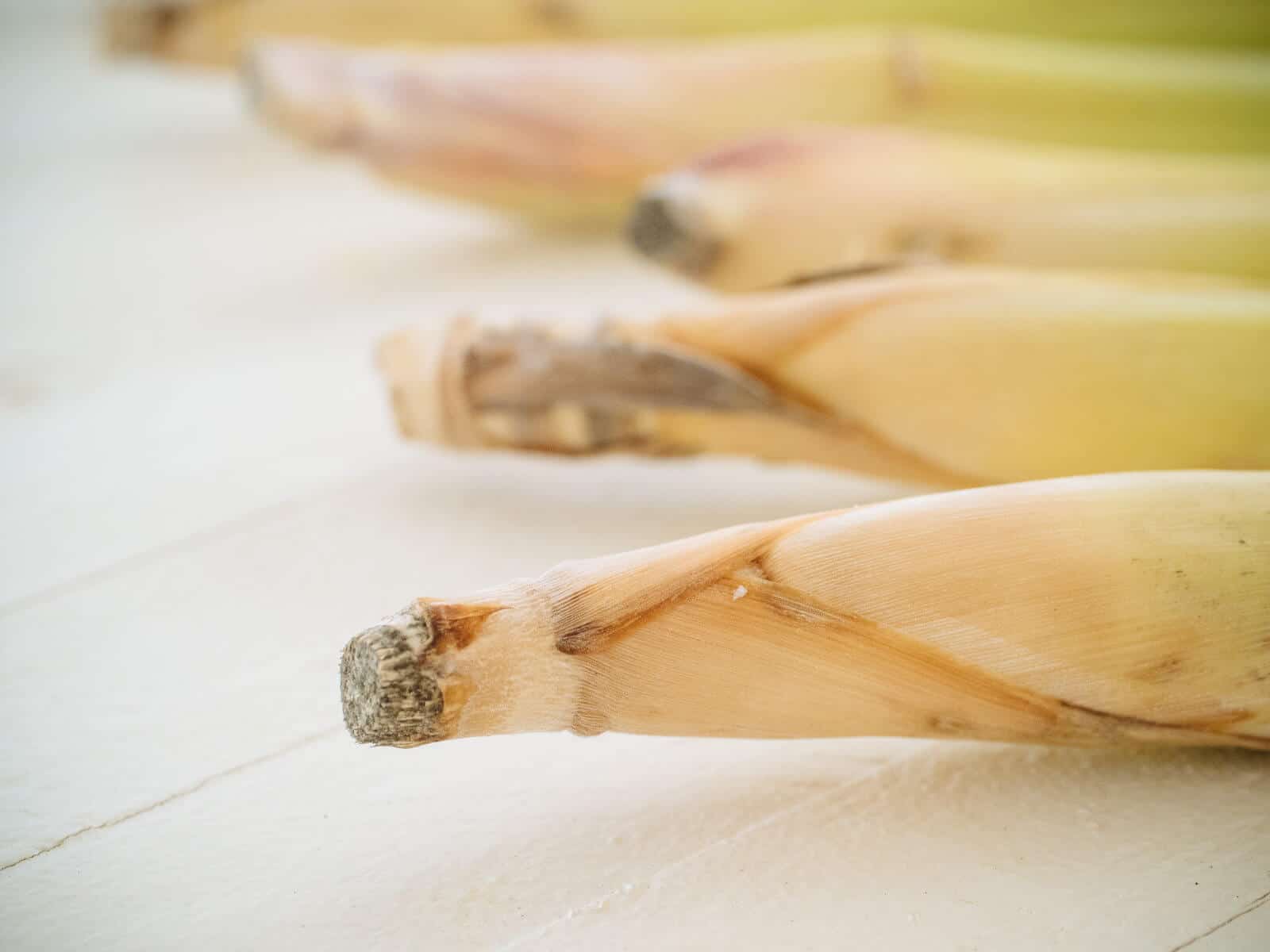
This is important to note because some store-bought stalks come with the bottoms cut off — and those won’t work for propagation.
Start with at least five or six healthy stalks. Not all of them may root, so this ensures you get enough rooted stalks to start a new plant off quickly.
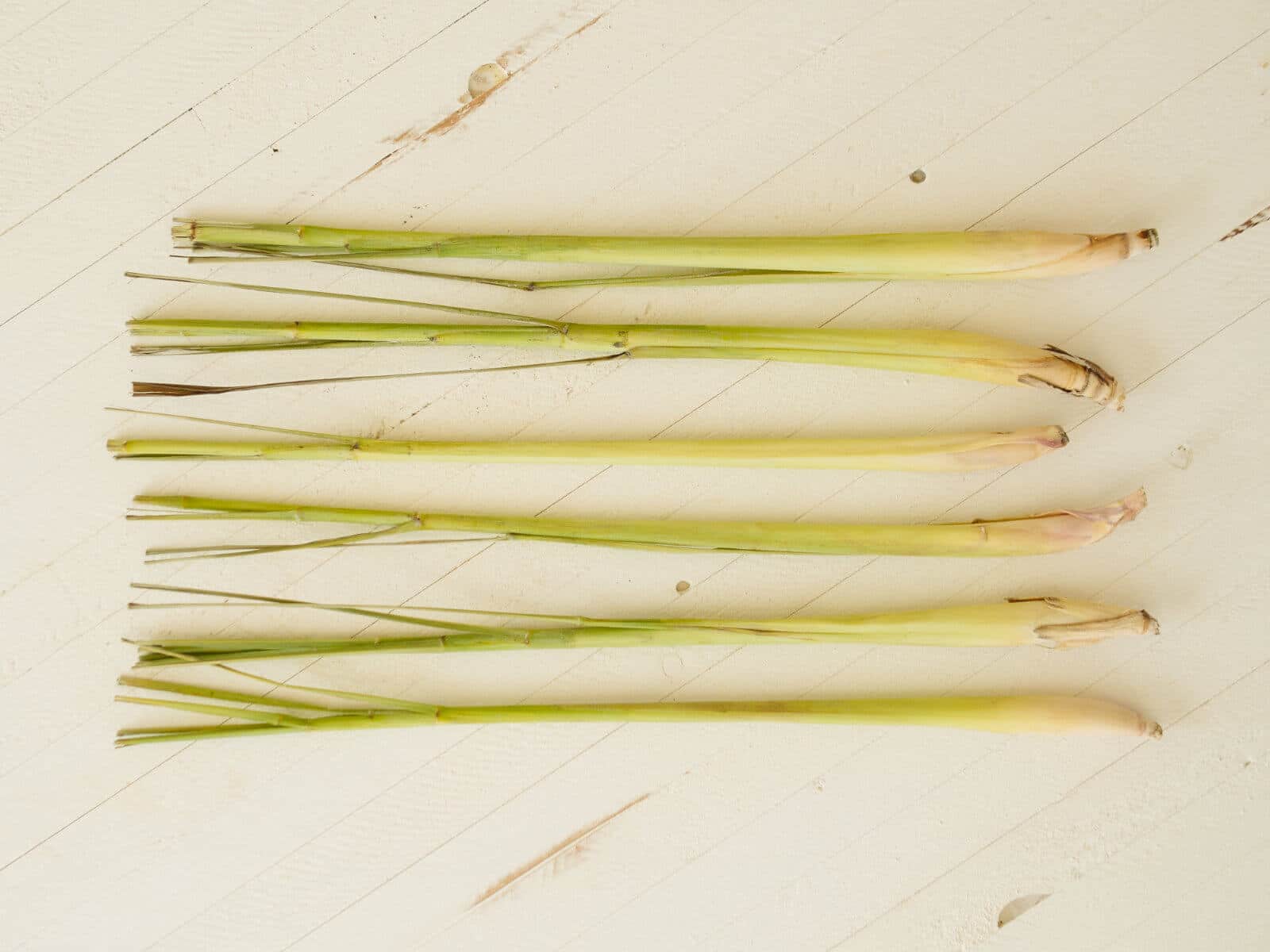
2. Trim any brown, older leaves.
To start, cut off the stiff, topmost leaves where they start to split apart. You can simply make a fresh cut (a few inches down) across the top of the stalks. Getting rid of the dead foliage just keeps things neater, as they’ll eventually fall off and turn slimy anyway.
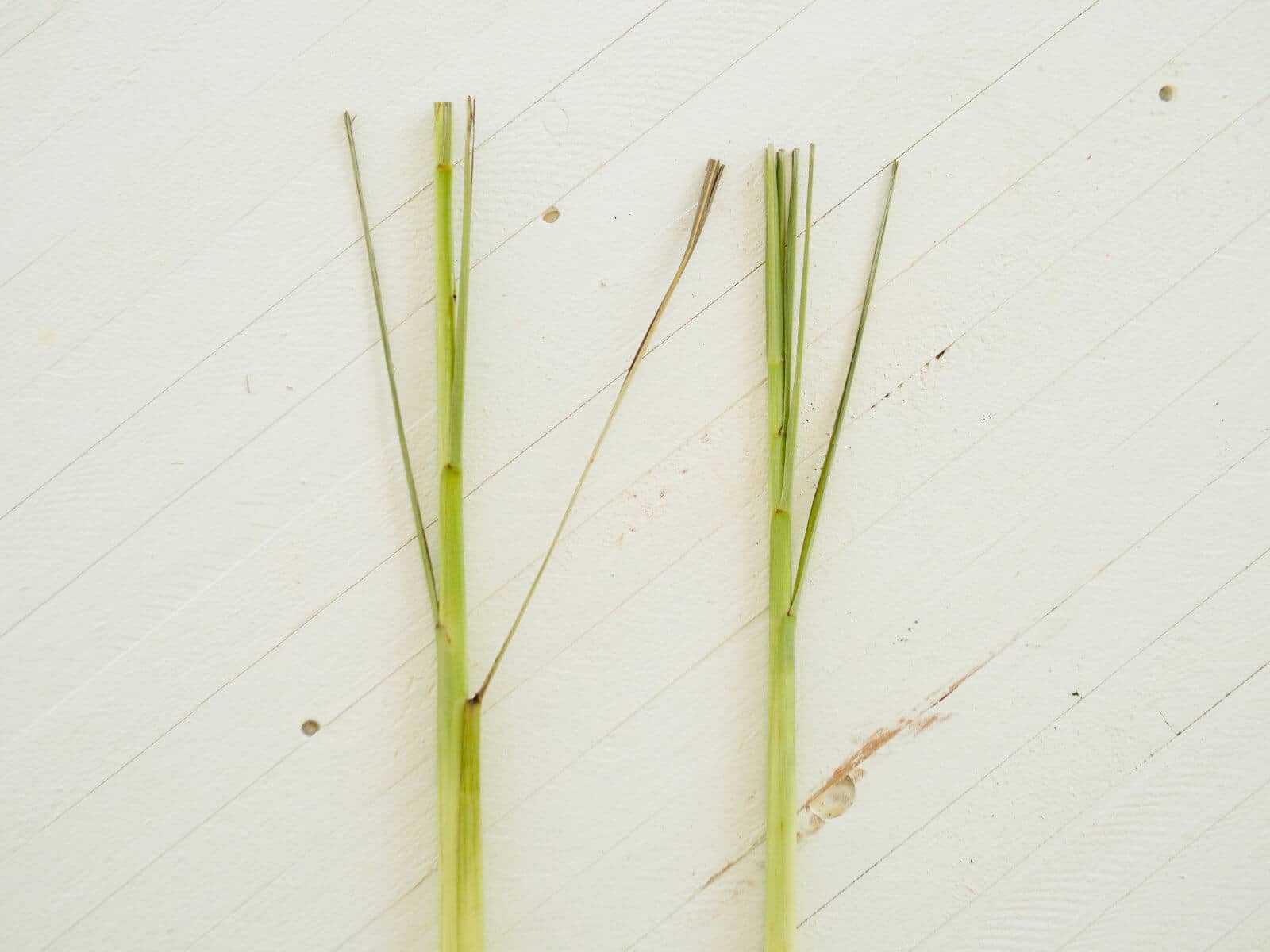
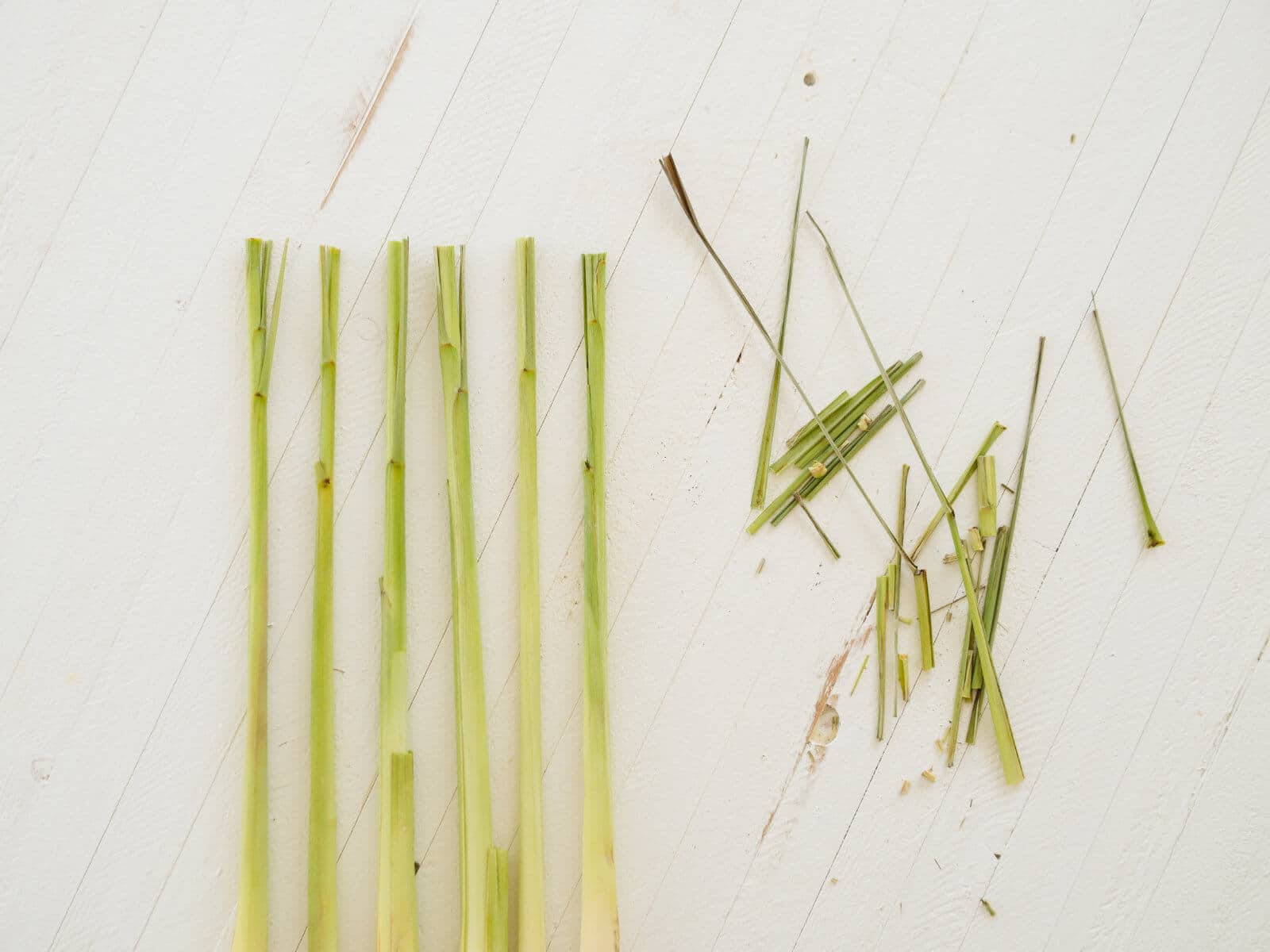
Try to resist peeling the woody outer layers that form the stem, as new leaves will grow from within these layers.
3. Place the lemongrass stalks in water.
Put the stalks in a jar or vase and fill with a few inches of water. Place the jar in a sunny location like a south-facing windowsill and then… just wait.
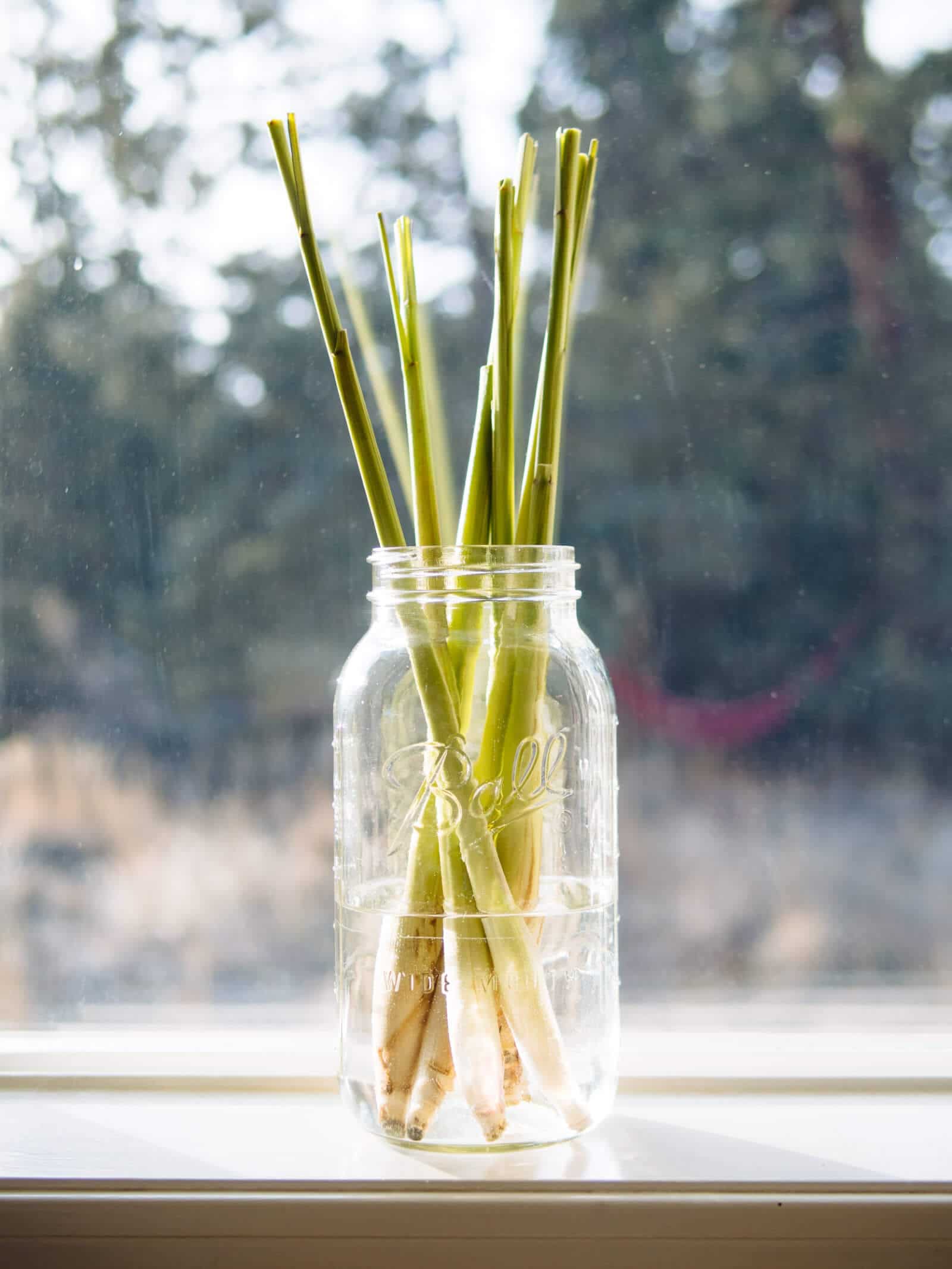

Change the water a couple times a week (or when it turns cloudy) and within a week, you should see new leaves begin to grow from the top. (But sometimes they won’t appear until much later, and I’ll explain why in the next step.)
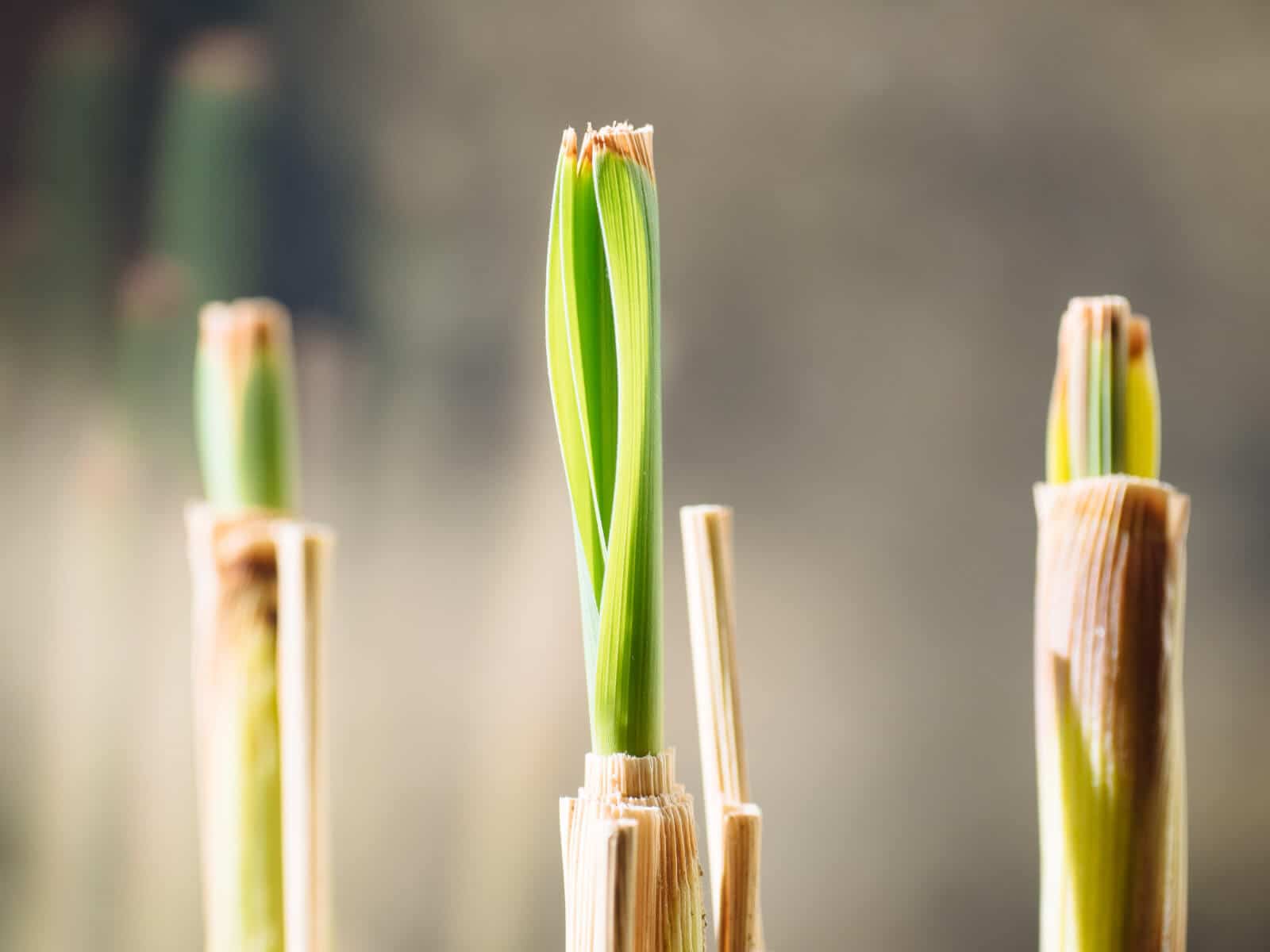
4. Continue changing the water until the roots grow nice and long.
New roots and leaves usually begin to emerge after about a week.
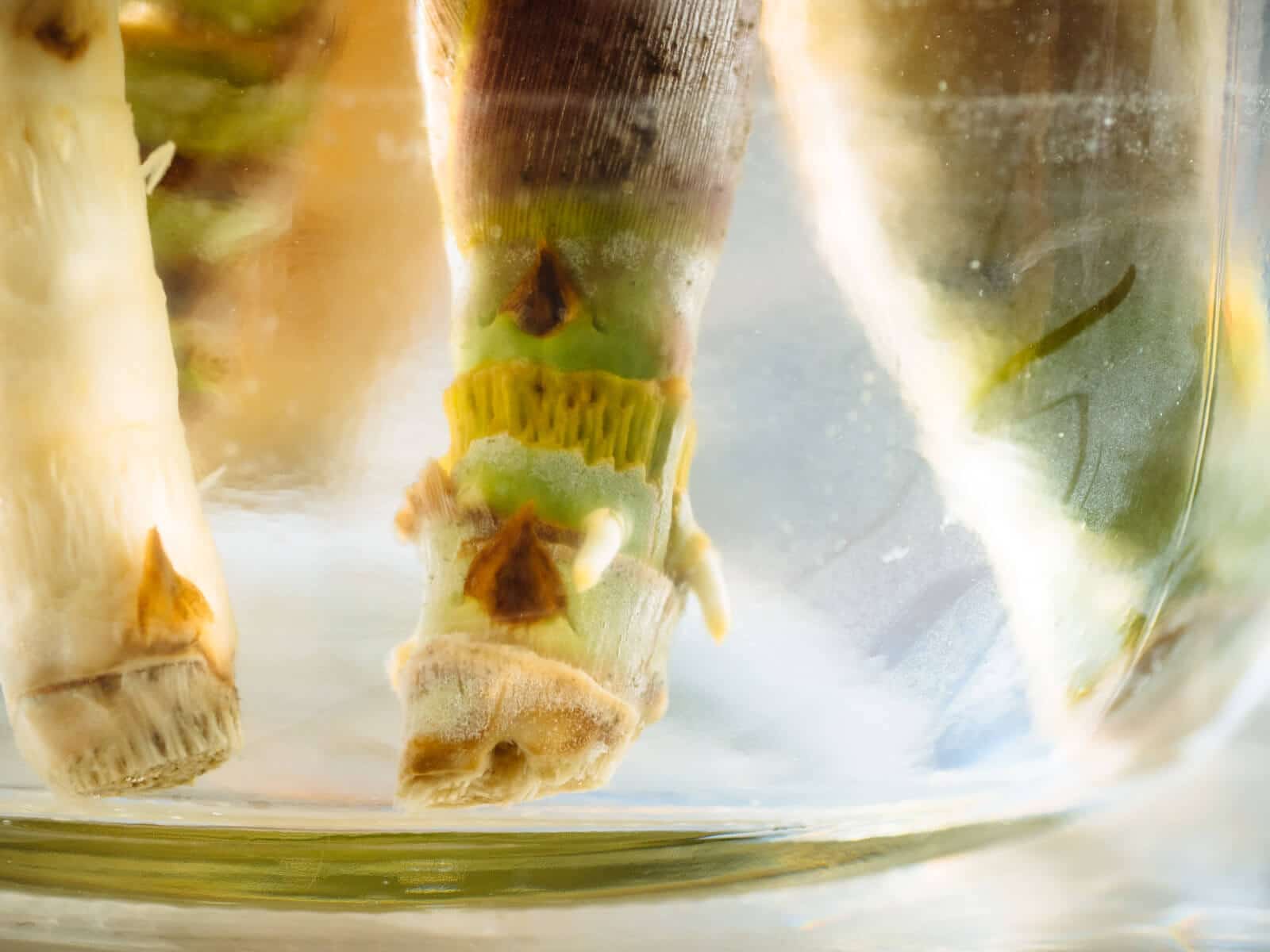
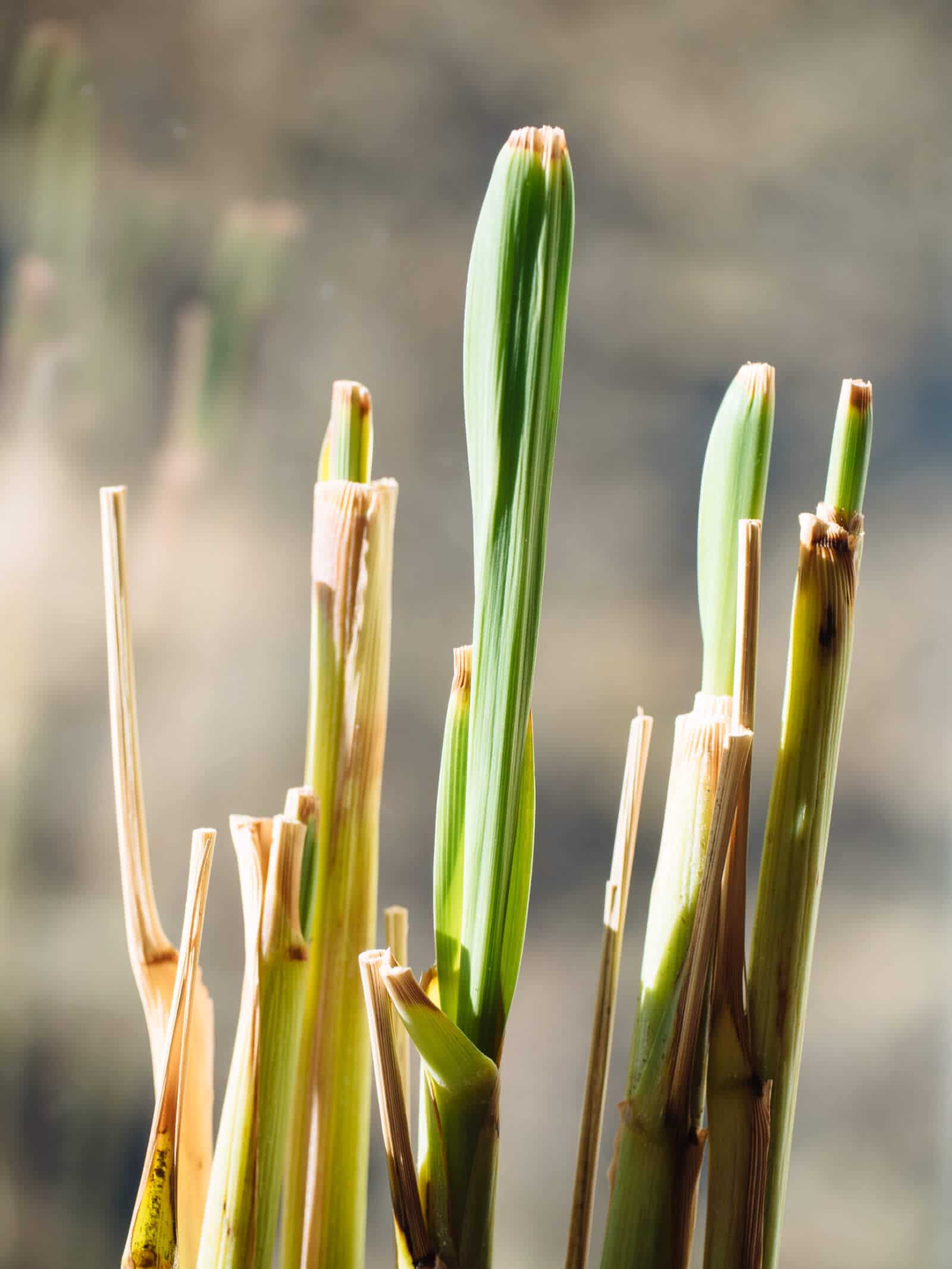
Wait until the roots are at least 3 inches long and the stalks have begun to divide (via offshoot stalks) before you plant them.
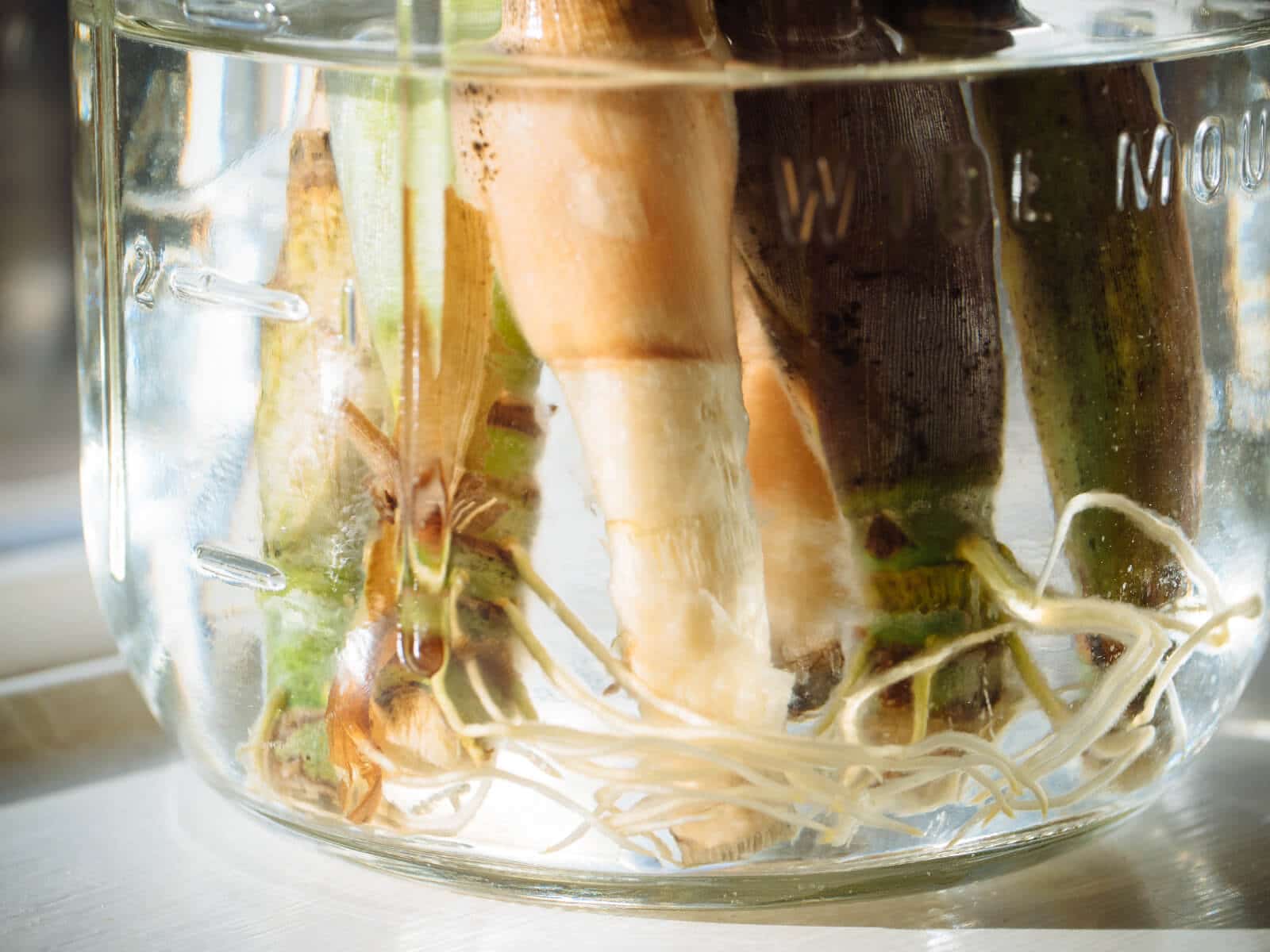
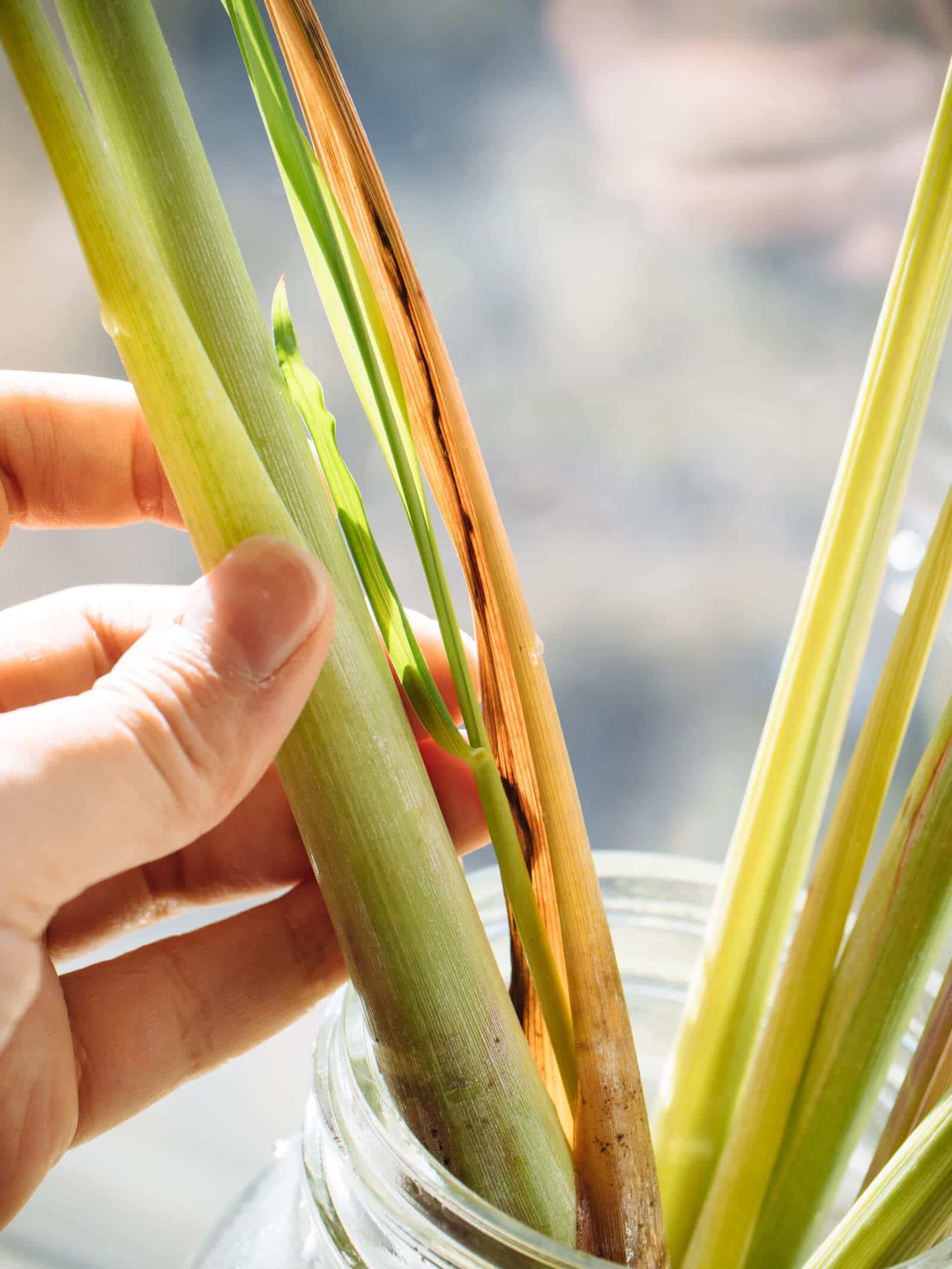
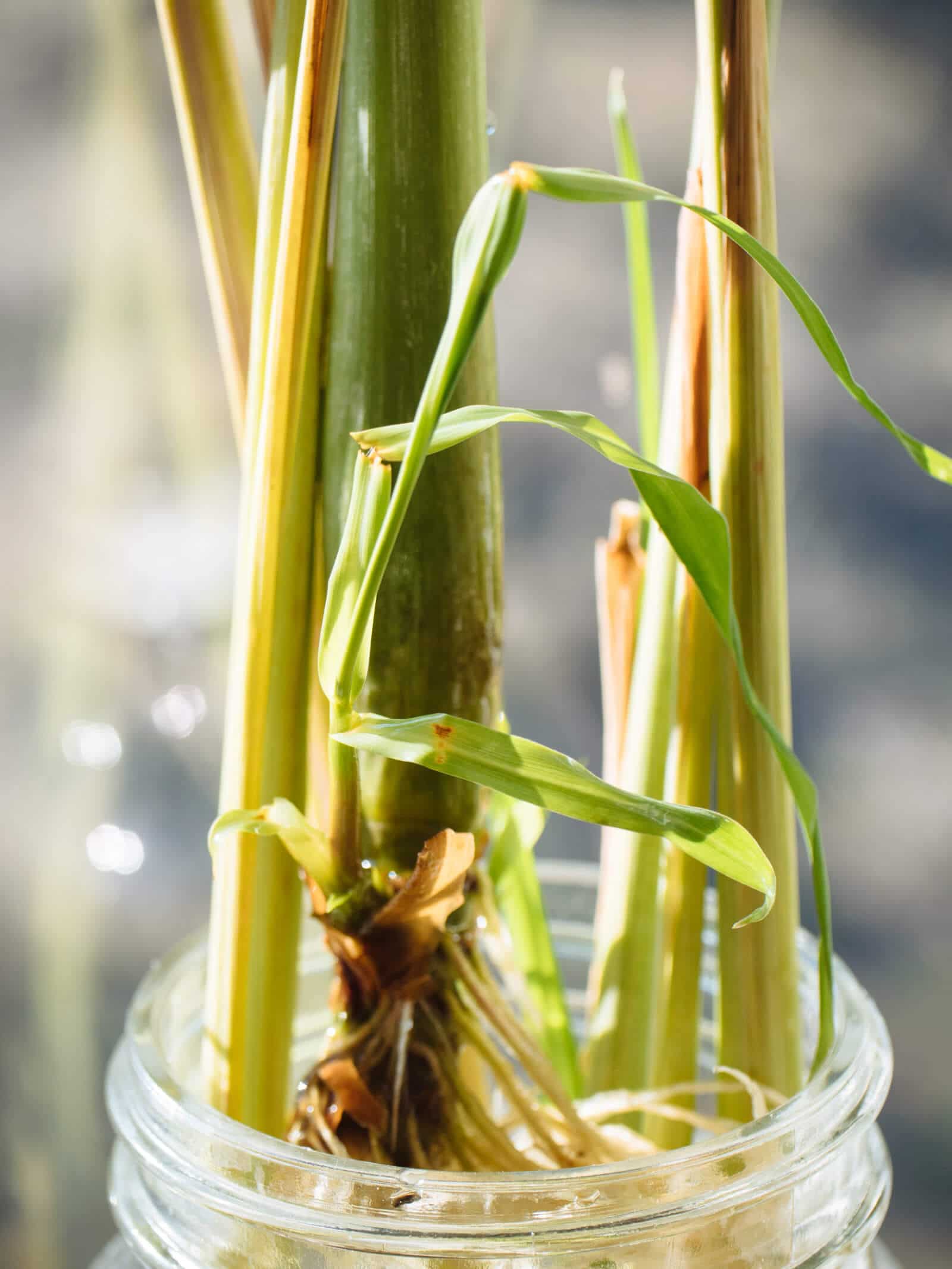
Here’s what I noticed my second time around with propagating lemongrass:
In summer (early September) in Southern California, the roots grew 1 centimeter in Week 1, then 2 to 3 inches in Week 2, and finally 4 to 5 inches in Week 3.
By the end of the third week, the plants were ready to go in the ground.
Contrast that with Central Oregon, where I started rooting the lemongrass in fall (late November) in a sunny window:
Little nubs of roots started appearing in Week 2.
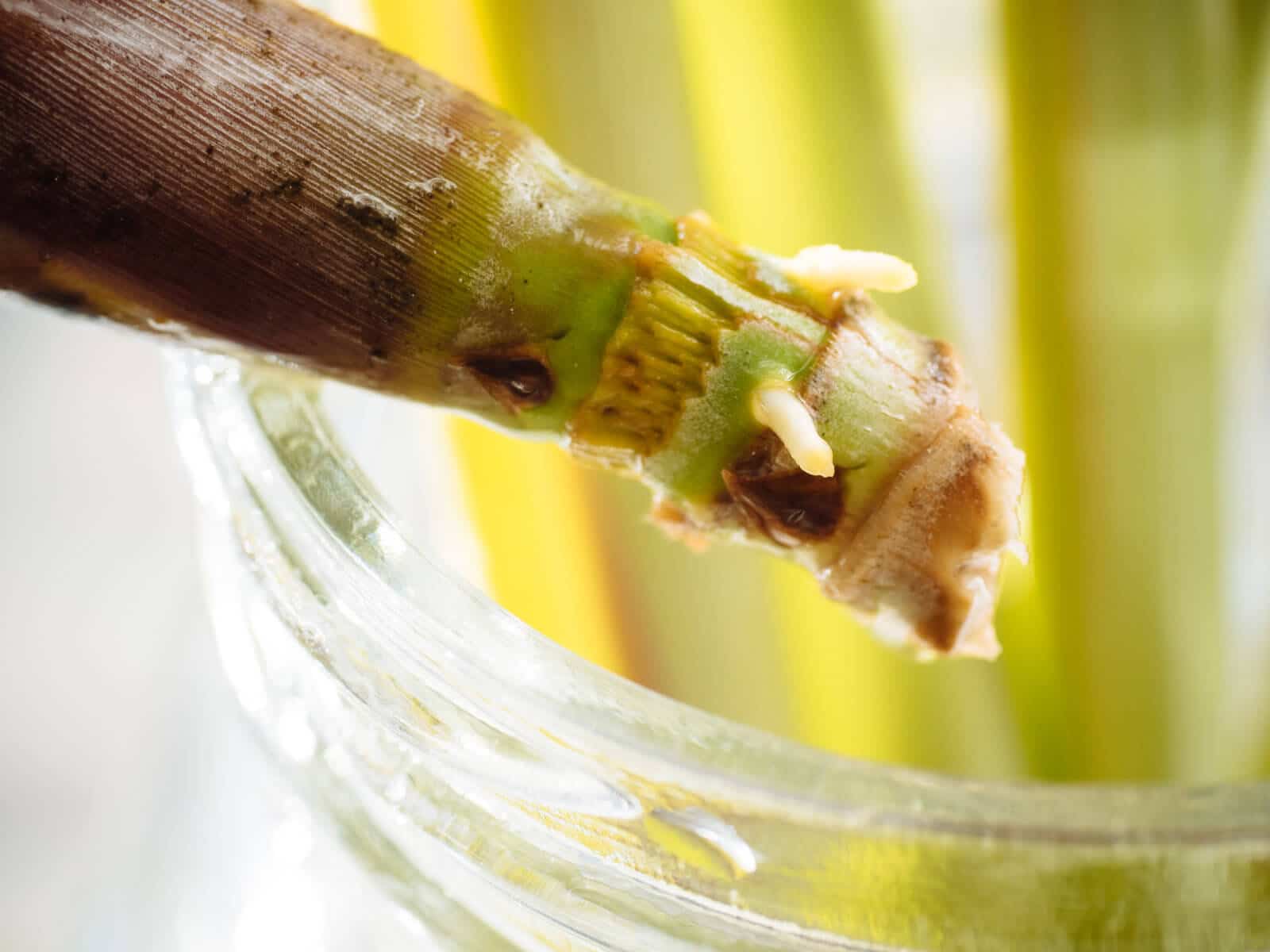
The late bloomers only hinted they were still alive with tiny white dots!
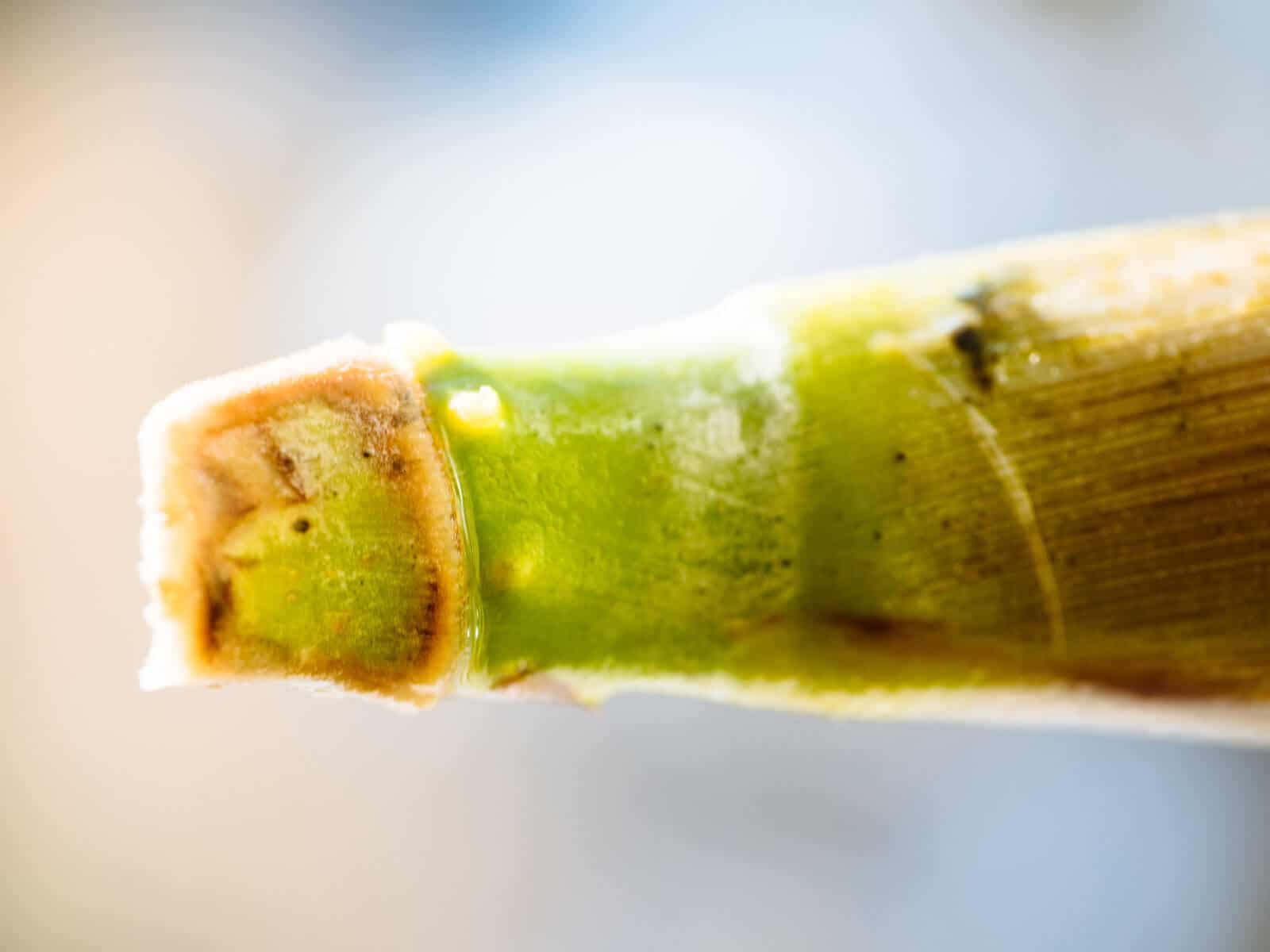
Fast forward to one month later (early January), the first stalks had roots that were 2 inches long.

The roots on the late bloomers didn’t reach 2 inches until a few weeks after that (in late January).
As you can see here, there was even a super late bloomer that didn’t start rooting until Month 2!
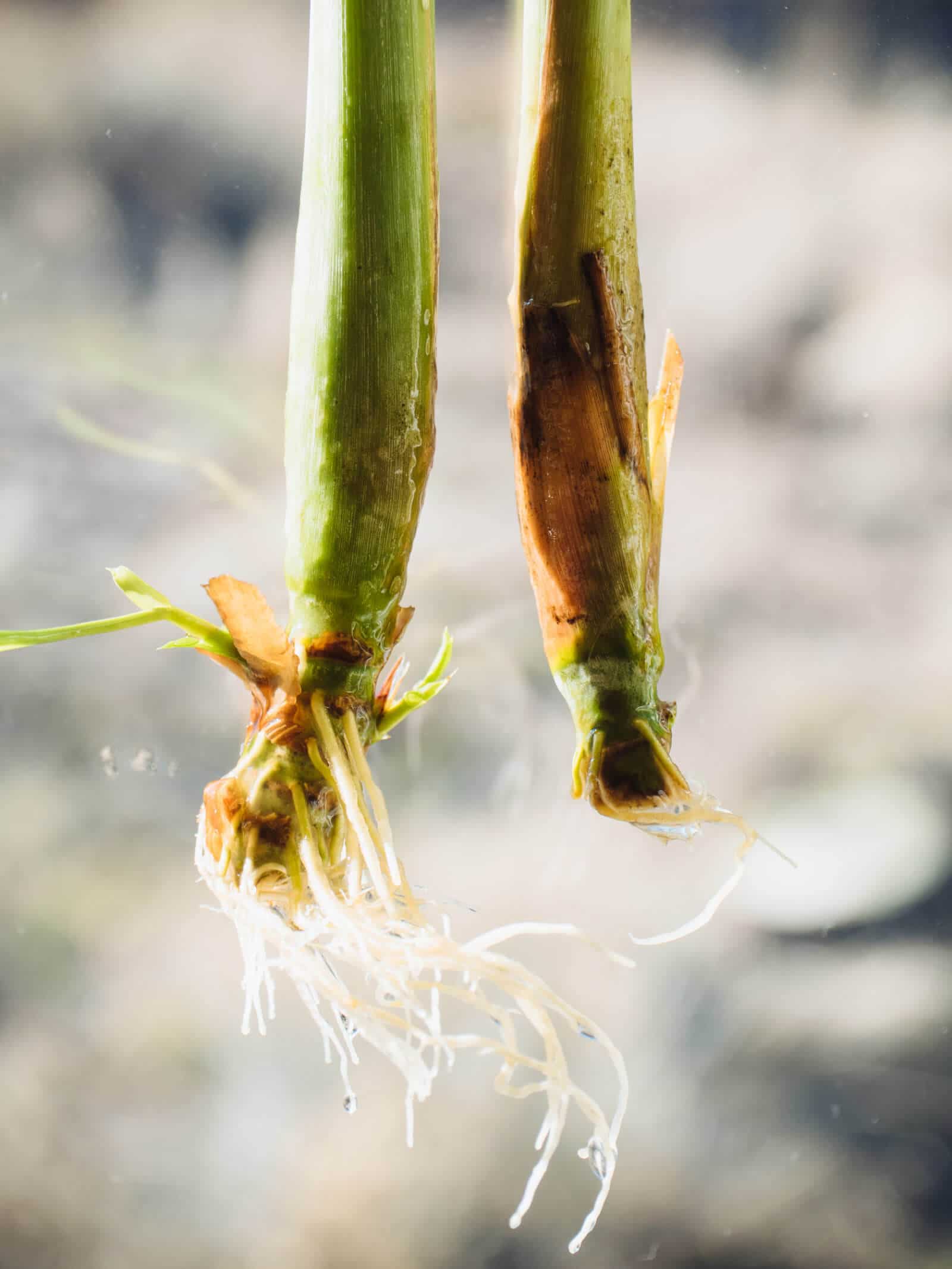
The amount of light and heat that comes through your window matters if you want fast-growing lemongrass.
So rooting them in winter or putting them in a north-facing window will significantly slow their development. As long as you continue to change out the water each week, however, the stalks will keep humming along until they’re ready to grow.
Don’t get discouraged and give up unless you see any stalks rotting in water. Out of the six stalks I tried, only four rooted—but one of them took its sweet time and started rooting right before I almost wrote it off. (It eventually had a growth spurt once we passed the solstice and the days got longer.)
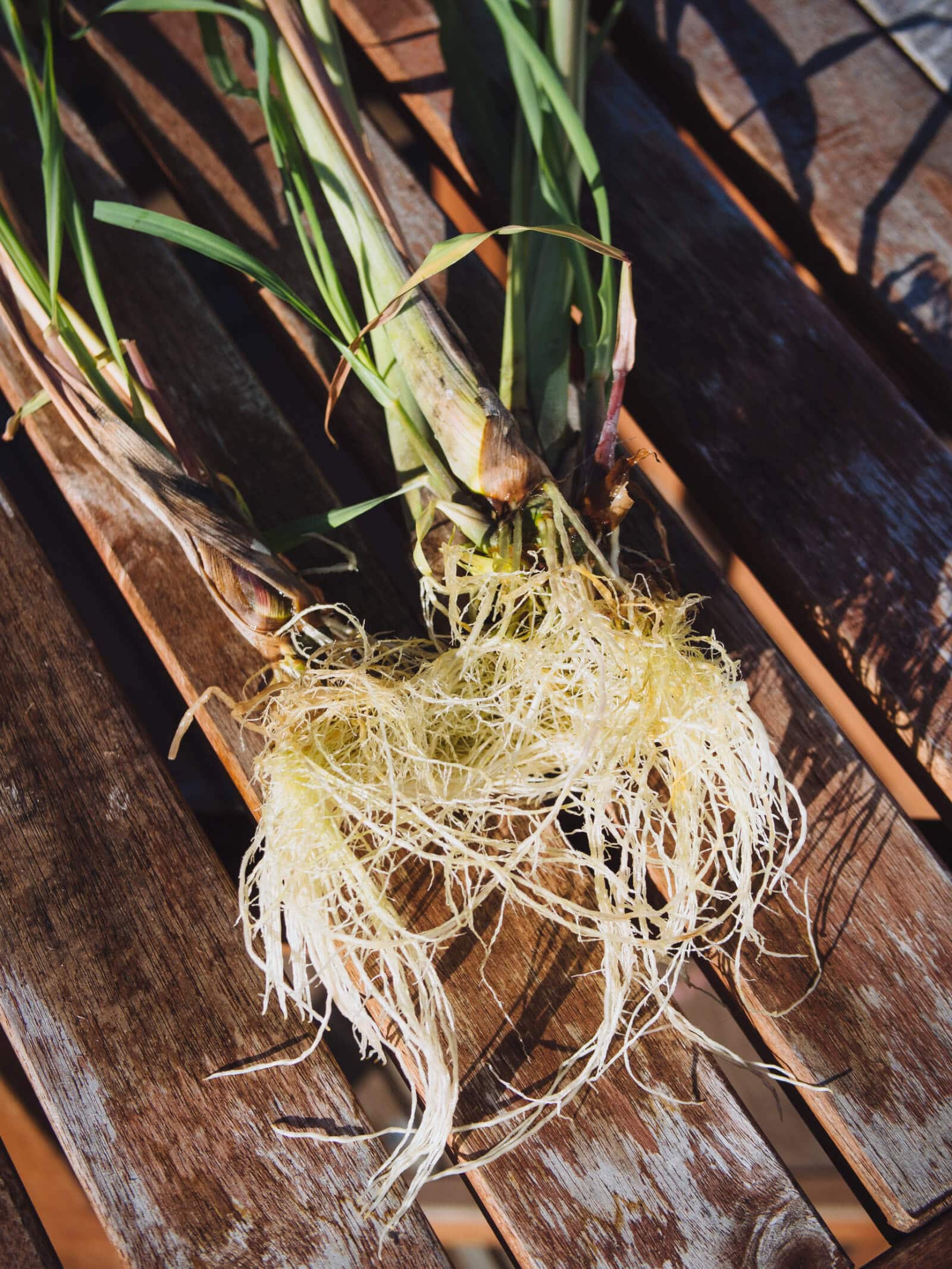
5. Prepare a nutrient-rich bed of soil for planting the rooted stalks.
Lemongrass is an herbaceous perennial that likes rich, moist soil, ample sunshine, and warmth.
Picture it in its native tropical and sub-tropical conditions — if you live north of zone 9a, you’ll need to grow lemongrass as a potted plant.
Gardeners in zone 8 might be able to keep lemongrass alive in the ground, but at the first freeze, the foliage will die back.
Related: Find your first and last frost dates with my custom planting calendar
You can up your chances of the plant coming back in spring if you apply a thick layer of mulch on the soil to keep the roots warm over winter.
Disclosure: If you shop from my article or make a purchase through one of my links, I may receive commissions on some of the products I recommend.
I recommend a high-quality potting soil (you can use store-bought or homemade potting soil) amended with compost, worm castings, and/or an all-purpose organic fertilizer.
Like all grasses, lemongrass is a heavy feeder (meaning a plant that needs lots of nitrogen and other nutrients), so at its peak between June and September every year, it benefits from a slow-release organic fertilizer to help it thrive.
For containers, you can plant a single stalk in a 3-gallon pot to keep it as a houseplant.
If you want the herb to grow into a size you can harvest, plant several stalks together in a minimum 5-gallon pot.
I like these fabric pots because they air prune the roots, resulting in big, beautiful plants that never get rootbound. It’s the same product I use for growing tomatoes in containers—you won’t go back to plastic pots once you try fabric.
Just be sure you pay attention to the brand you buy; most fabric pots only last a few years unless you choose the non-degradable versions from Root Pouch.
My recommendation? If you cook with lemongrass fairly regularly, start with a 5-gallon pot, then move the clump into a 10-gallon pot once it’s nice and bushy.
Lemongrass will grow as big as you let it, so keep in mind the amount of space you have and how much lemongrass you want to harvest.
Read more: Find out how deep the roots of your vegetables will grow in the garden
In a garden bed, plant at least three stalks together for a larger yield.
Because it likes moisture, lemongrass doesn’t mind soil on the clay-ey side (particularly in drier climates), but it should never sit in soggy soil. If you live in a rainy region, your soil should be well-draining to keep the stalks from rotting.
With optimal conditions and plenty of sunshine, lemongrass in the ground can grow into quite a hefty shrub, about 5 feet tall and wide, and sometimes even more.
It can become so dense that some people even grow the herb as a screen or hedge, so be sure to pick a spacious permanent area in your yard for it.
Did you know?
Lemongrass (Cymbopogon sp.) is the source of citronella oil, a natural mosquito repellent. Because of this, it’s sometimes called the citronella plant but should not be confused with the other citronella plant, Pelargonium ‘Citrosum’.
6. Plant the lemongrass stalks in soil with the crowns just below the surface.
The crown is the base of the stalk. Cover it lightly with soil but don’t bury the whole stalk.
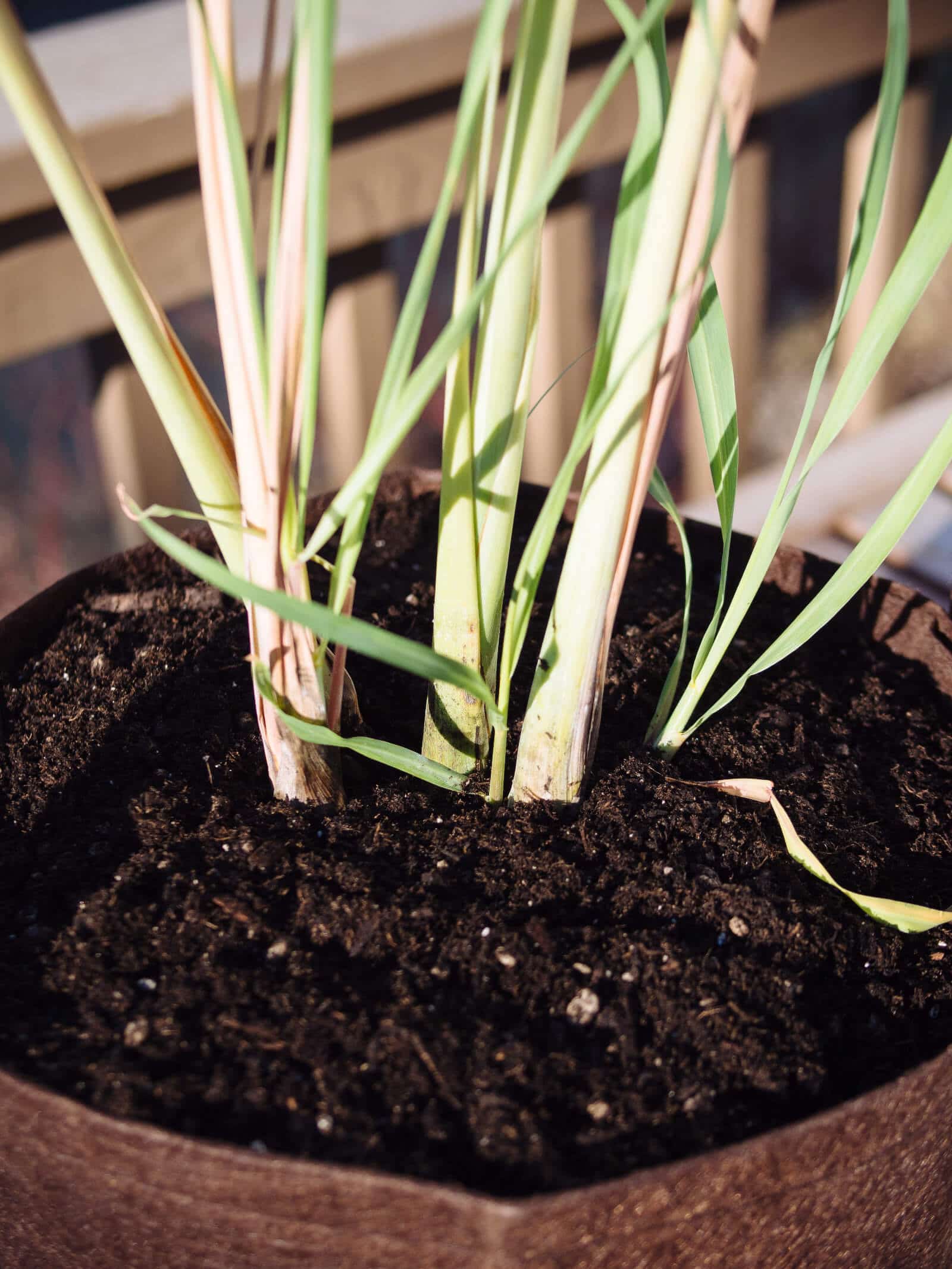

Water thoroughly and spread a thick layer of organic mulch around the plant (being careful not to pile the mulch up against the base) to conserve moisture. I like using wood chips, but shredded bark, shredded leaves, or straw also work.
Keep the soil evenly and lightly damp, but not waterlogged.
In its native environment, lemongrass prefers regular rainfall and humid conditions, so this is one of the rare instances where I recommend irrigating the plant from overhead, especially if your summers tend to be very hot and dry.
7. Harvest your lemongrass (and give your friends some free plants).
Your lemongrass should be ready for harvest in two to four months. Wait for the stalks to reach at least 12 inches tall (not including the green leaves) and 1/2 inch wide at the base.
Harvest the stalk by snapping off or cutting the stalk about an inch above the ground. It will continue to grow and divide over time.
Propagating lemongrass from an existing plant is even easier than propagating from store-bought stalks. You can cut the stalk away from the plant (with rootstock intact) to share with a friend.
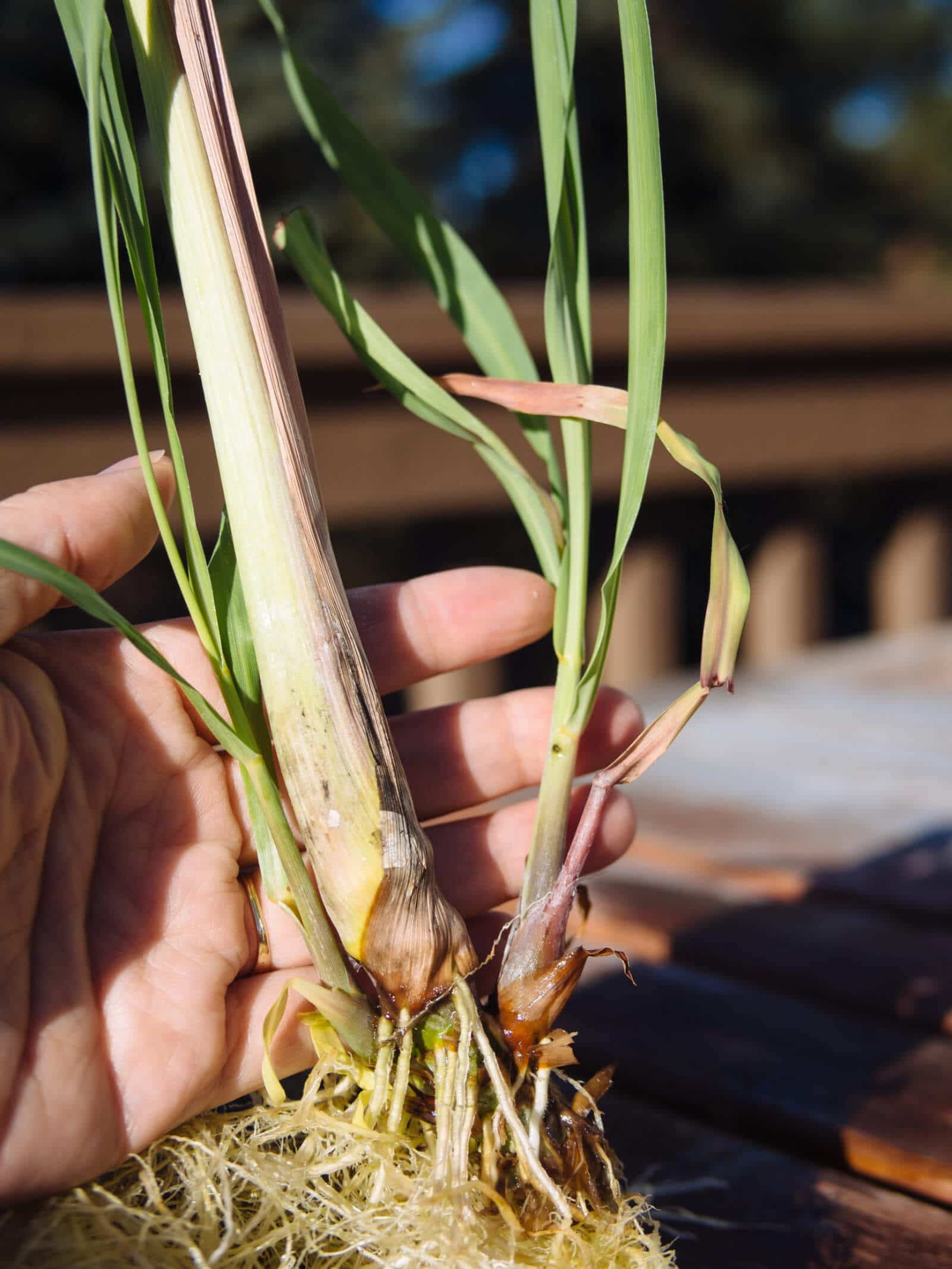
If your lemongrass has gotten too unwieldy, you can dig up the clump, divide it, and plant the baby clumps around your yard.
Keep your lemongrass pruned each year for a tidier look, or let the leaves fan out and enjoy its beautiful fountain-like form.
How to Propagate Lemongrass From Store-Bought Stalks

Lemongrass is one of the easiest herbs to propagate. Just buy a few stalks from the store, put them in water, and watch them root!
Materials
- 1 jar
- 6 fresh lemongrass stalks
- 5-gallon container
- 1 cubic foot of high-quality potting soil
- Organic all-purpose fertilizer
- Organic mulch
Tools
- Garden scissors
- Trowel
Instructions
- Start with fresh lemongrass with the entire stem intact. The stalks you buy don't need (and probably won't have) roots at the bottom, but they do need to have the the entire stem (base) intact.
- Trim any brown, older leaves. To start, cut off the stiff, topmost leaves where they start to split apart. You can simply make a fresh cut (a few inches down) across the top of the stalks. Try to resist peeling the woody outer layers that form the stem, as new leaves will grow from within these layers.
- Place the lemongrass stalks in water. Put the stalks in a jar or vase and fill with a few inches of water. Place the jar in a sunny location like a south-facing windowsill and then... just wait. (See Notes below.)
- Continue changing the water until the roots grow nice and long. New roots and leaves usually begin to emerge after about a week. Wait until the roots are at least 3 inches long and the stalks have begun to divide (via offshoot stalks) before you plant them.
- Prepare a nutrient-rich bed of soil for planting the rooted stalks. Fill your container with potting soil and stir in all-purpose fertilizer (following the package directions).
- Plant the lemongrass stalks in soil with the crowns just below the surface. The crown is the base of the stalk. Cover it lightly with soil but don't bury the whole stalk. Water thoroughly and spread a thick layer of organic mulch around the plant (being careful not to pile the mulch up against the base) to
conserve moisture. Keep the soil evenly and lightly damp, but not waterlogged. - Harvest your lemongrass. Your lemongrass should be ready for harvest in two to four months. Wait for the stalks to reach at least 12 inches tall (not including the green leaves) and 1/2 inch wide at the base. Harvest the stalk by snapping off or cutting the stalk about an inch above the ground. It will continue to grow and divide over time.
Notes
Rooting time will vary considerably depending on the time of year you propagate your lemongrass (quicker in summer, slower in winter).
In optimal summer conditions, roots may begin to emerge the first week and be ready for planting within a month. In low-light conditions, roots may not appear until a couple of weeks in, or be ready for planting for at least two months.
The amount of light and heat that comes through your window matters if you want fast-growing lemongrass.
This post updated from an article that originally appeared on October 1, 2010.


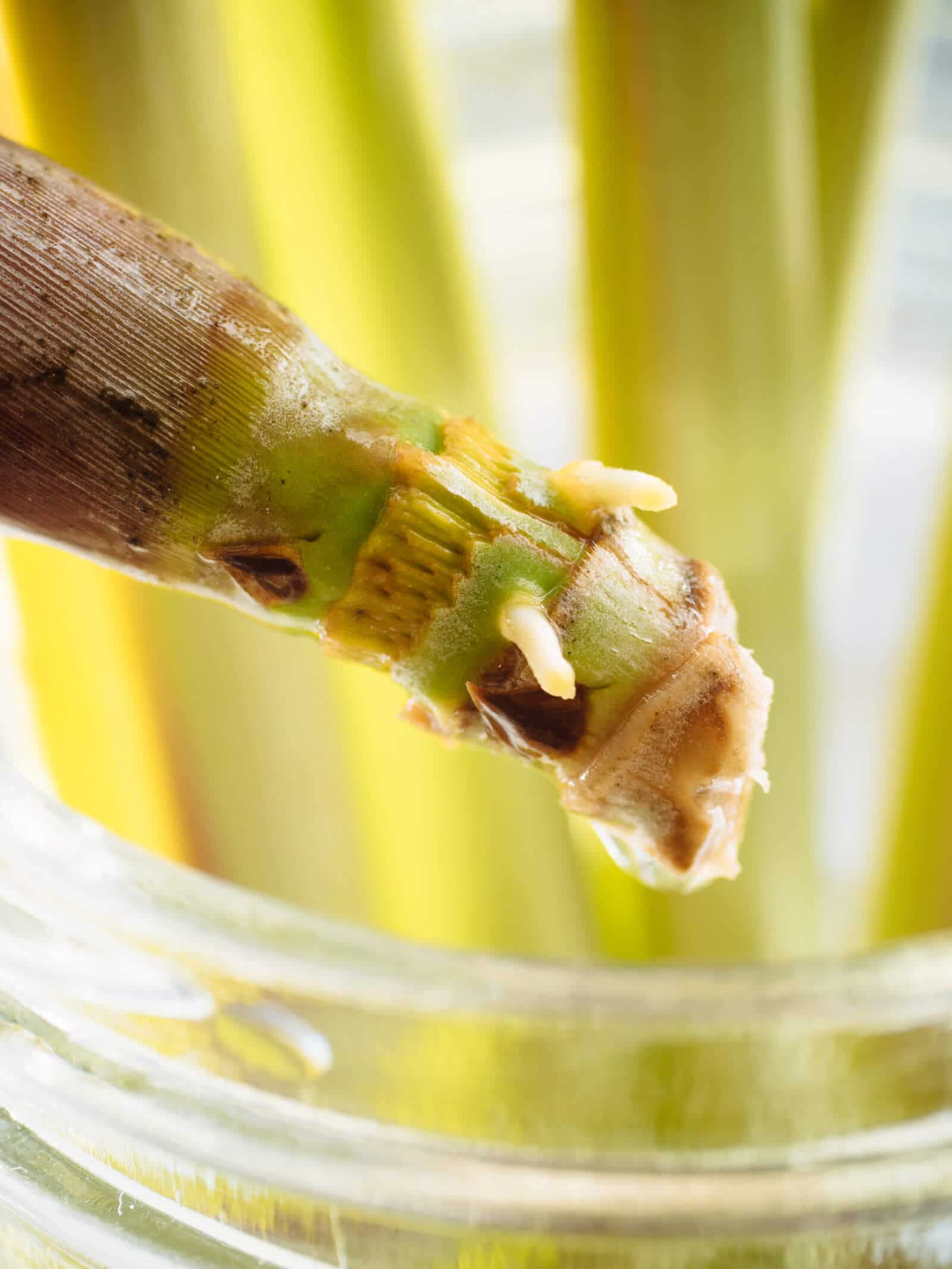













I followed your link for fabric bags/pots on Amazon. The description says they are made of plastic. So we aren’t getting any real improvement here.
Is there any such thing as real fabric pots or bags? I’ve been looking. So far it appears the best way is to. simply make them myself out of burlap material.
Moving to the UK from SE Asia, I’ve missed freely available lemongrass. I’ve followed your instructions and now have two plants to pot out. I am beyond excited!! Thank you for the clear directions – I’m looking forward to some great cooking in a few months.
Wonderful well explained information. Just what I was looking for thank you!
Hi Linda, I’m an urban gardener in concrete jungle of New York City 🙂 The lemongrass stalks are happily growing roots. Next step is to transfer them to a large pot and maybe live on the corner of my fire escape.. What potting soil should I use? I can’t possibly buy (and store) all the things you recommended (compost, AP fertilizer, worm casting, etc.). If I can just plant them with one type of soil, what should I use?
Beautiful and I’ve read that they also repel mosquitos, as a natural source of citronella. 🙂
Yes, it can help in that respect!
I know a bit late (since 2010) but just to say thank you for the tips! Failed twice transplanting direct from another plant but this is great.. markets in Bangkok of course full of lemongrass but nice to have some fresh lemon grass tea too 🙂 Ciao for now
Good luck with your new transplants!
How deep did you plant these? It’s a little hard to tell from the picture.
I planted the stalks a couple inches in the soil – just enough to keep them stable and upright.
Awesome, thanks. I did two stalks like you suggested here, but only one sprouted roots (both were whole stalks). Not sure why. The one that didn’t sprout roots is still growing leaves, for whatever reason. But I’m about ready to plant out the sprouted one; it’s getting pretty long.
If the unsprouted stalk has been in water for about a month with no roots yet, you should probably try again with a new one. Depending on how often you use lemongrass though, one stalk may be all you need; mine has multiplied like crazy!
How many stalks can you plant together at the same time. I see in the picture you planted 4-5 is that what you call a clump? How far should you plant clumps of lemongrass?
You can plant as many as you want together, though they do multiply quickly and easily, so keep that in mind if you have limited space. I planted three stalks together (the extra stems you might be seeing are offshoots). Nearly three years later, this is how they look: http://gardenbetty.com/2013/05/two-year-lemongrass-update-and-how-to-tame-that-wild-thing/
Thanks Holly! And that’s wonderful about doing what you love for a living – everyone should be as lucky!
Excellent article! I love your blog and the tag line “diary of a dirty girl”, just great. I too love gardening, cooking, and herbs- all things about the home. I loved it do much we decided to make it our living.
http://themakingofahome.wordpress.com/
I will keep this in mind for when we have a polytunnel. Outside will not work here but it will either be the polytunnel or a pot inside the house. Lemongrass always represents sunshine and asian food which is a well needed distraction after having to endure a month of rain and cold. Thanks for that!